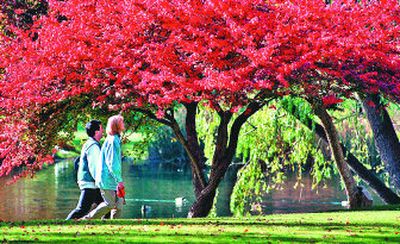Survey targets historic Cannon Hill

“Someone is outside photographing our house,” my husband announced over breakfast on a crisp October morning last fall. Following his gaze out the window of our Cannon Hill home, I saw a woman standing in the street, her face obscured by a camera.
“Who does she think she is?” I wondered aloud. It wasn’t until last week that we learned the answer. She, apparently, was my neighbor, Amy Shook, a member of the Spokane Preservation Advocates who volunteered to photograph roughly 300 homes in the area surrounding Cannon Hill Park.
Today those photos are part of a city of Spokane survey of an architecturally significant neighborhood on the upper South Hill – the Cannon Hill Park Addition. Last week Shook invited area residents to her own architecturally significant Cannon Hill home to discuss the project and its potential impact on our neighborhood, a 27-block-area of mostly bungalows loosely bounded by south Lincoln and south Bernard streets, and West 16th and West 25th avenues.
The area was rapidly developed around the turn of the century, and by the 1940s it comprised a high concentration of Craftsman, Tudor Revival and Colonial Revival homes on diagonal and curvilinear streets surrounding the 15-acre park.
Although there are seven historic additions on the upper South Hill, Cannon Hill Park Addition was selected as the first survey area because it contains the most cohesive development of historic homes surrounding a highly intact park designed by the Olmsted Brothers, according to Aimee E. Flinn, preservation specialist with the City-County of Spokane Historic Preservation Office.
Flinn says the project will use a $10,000 grant from the Washington State Department of Archaeology and Historic Preservation to hire a consultant who will work with volunteers and city staff to complete the survey later this year.
Ultimately the survey will be used to create an historic content statement on roughly 60 to 70 period bungalows in the Cannon Hill Park neighborhood.
“Cannon Hill has the best concentration of that style of home,” Flinn said, adding that the effort will specifically identify homes that could be eligible for historic designation. “So more individual homeowners can do their own nominations.”
Flinn said many homeowners are interested in researching the history of their homes, but are often daunted by the process. And the cost of hiring a consultant to do the research can cost up to $2,000.
“This would really make the local register process easier,” she said. In addition, the project could help with future efforts to survey historic homes in other upper South Hill additions, where there are potentially 2,000 to 3,000 properties that could be eligible for historic designation.
The project could also be used for future planning, including the potential to designate Cannon Hill Park Addition as a National Historic District, Flinn said.
“In most cases when we survey neighborhoods, we are surveying them with the intent of doing a national historic designation,” Flinn said. “But in this case we’re looking at using the information for a broader scope that we could use in a couple of ways. But I don’t doubt it will be eligible.”